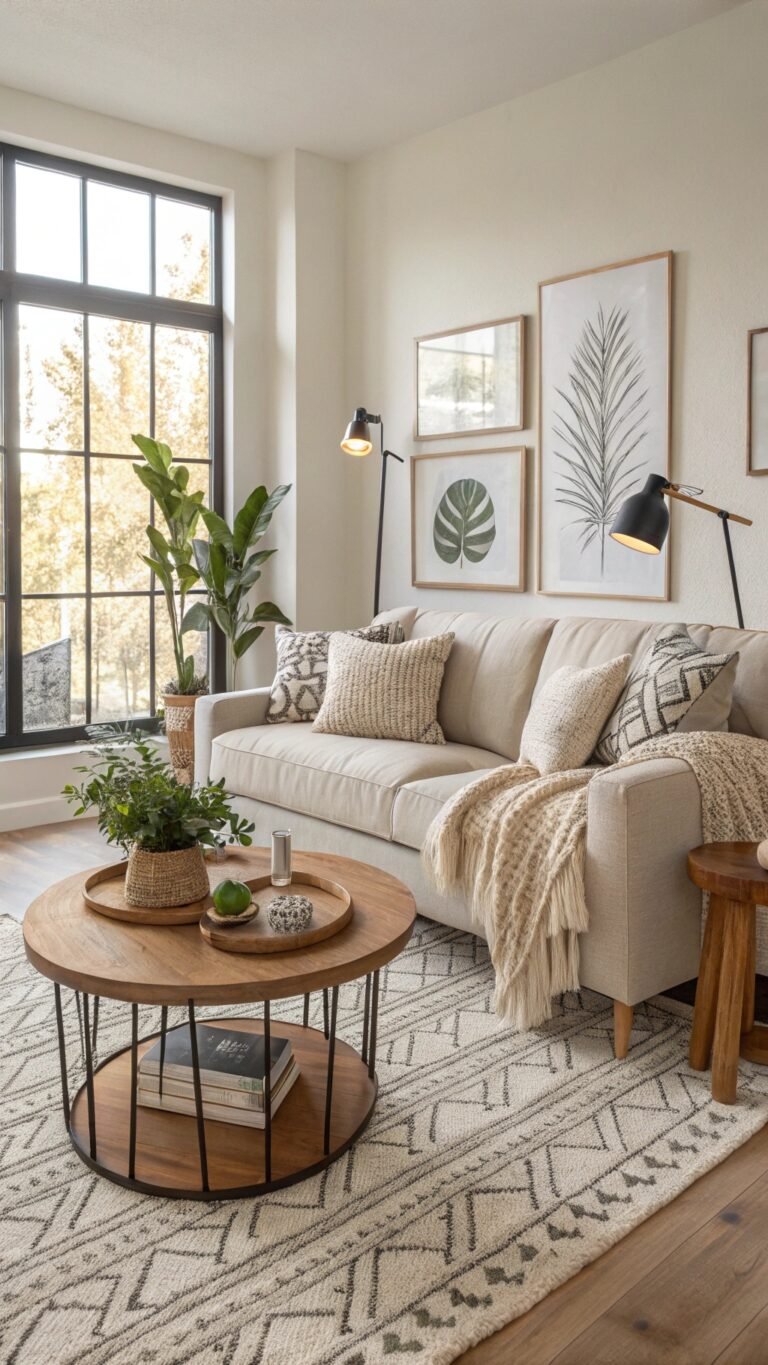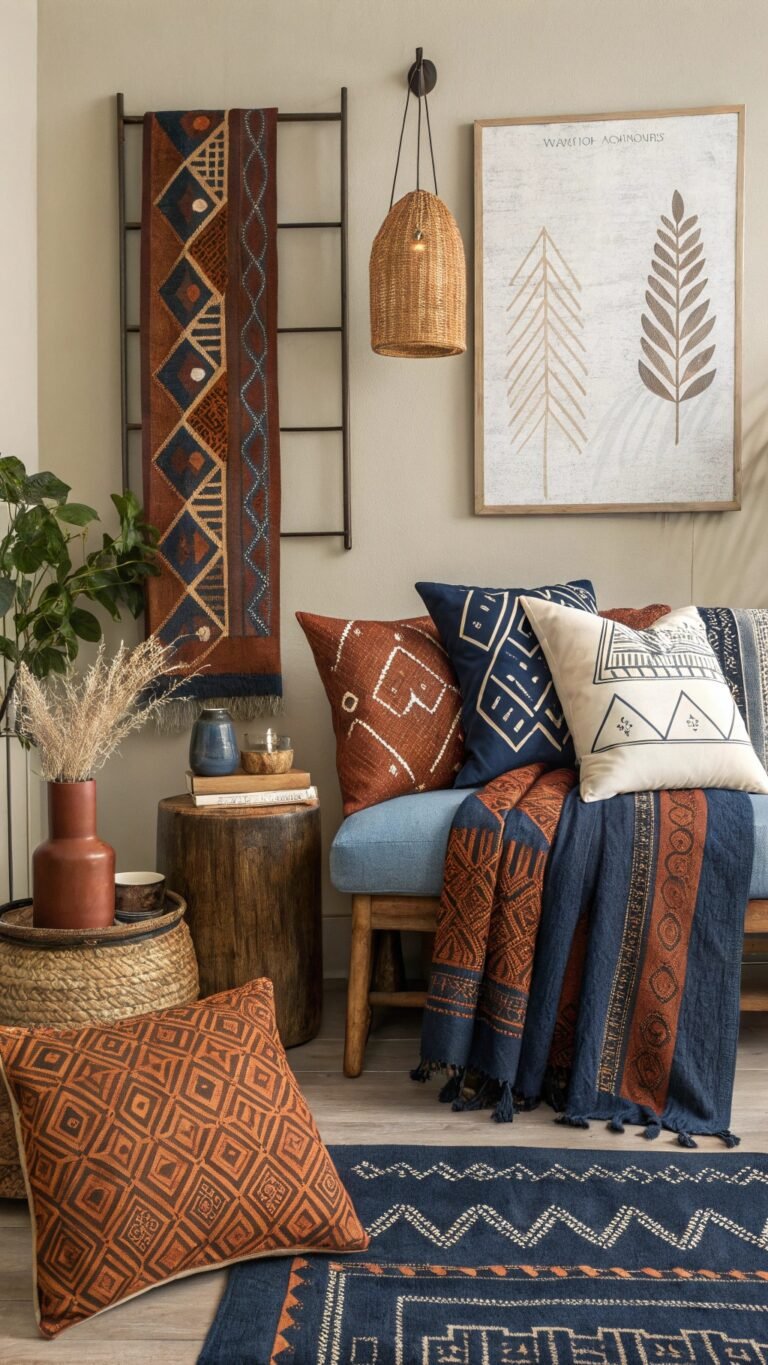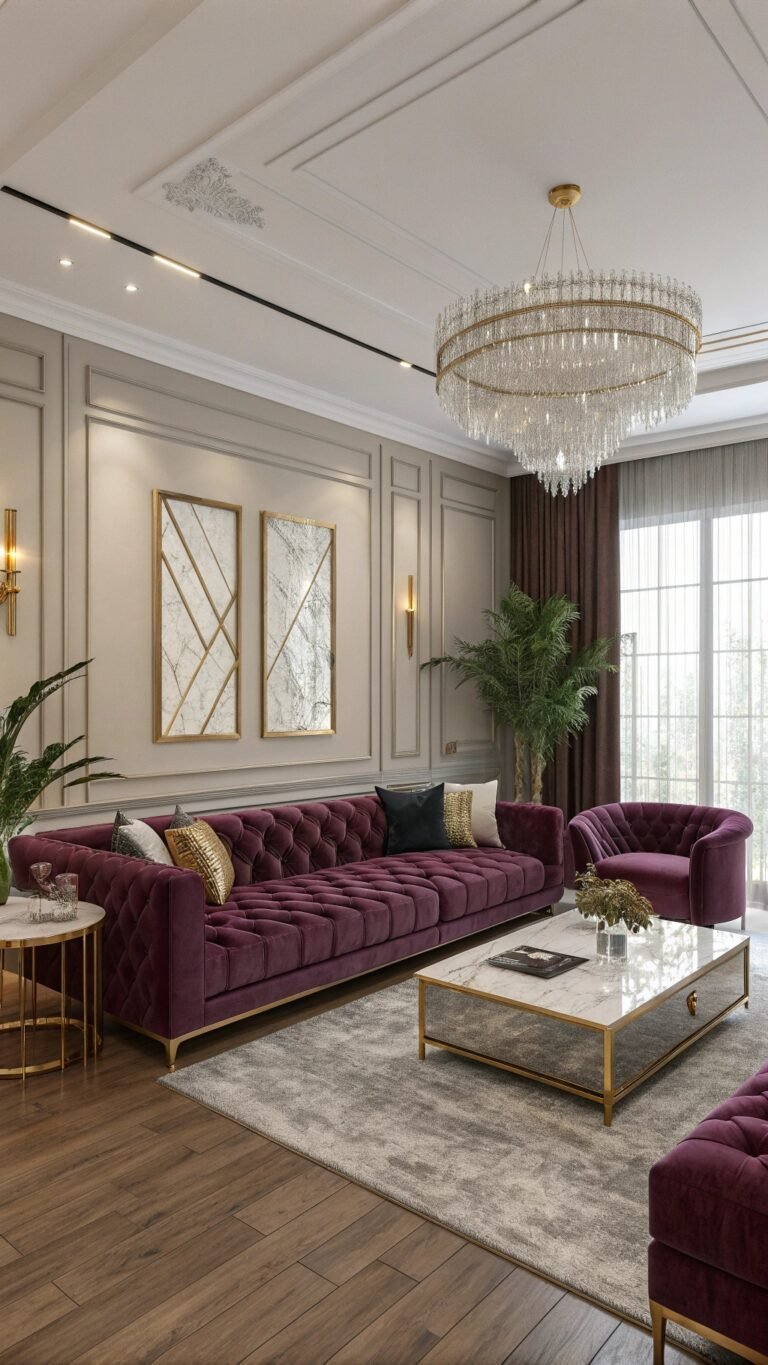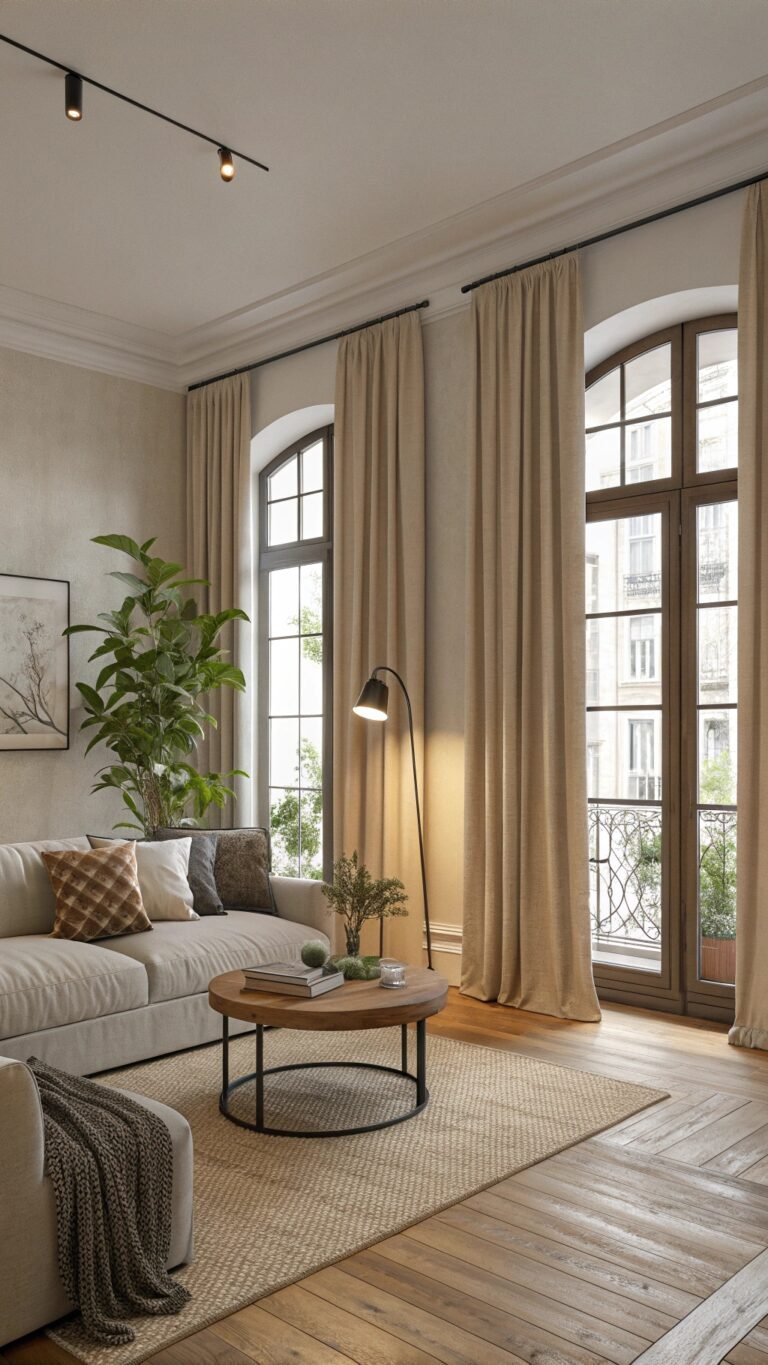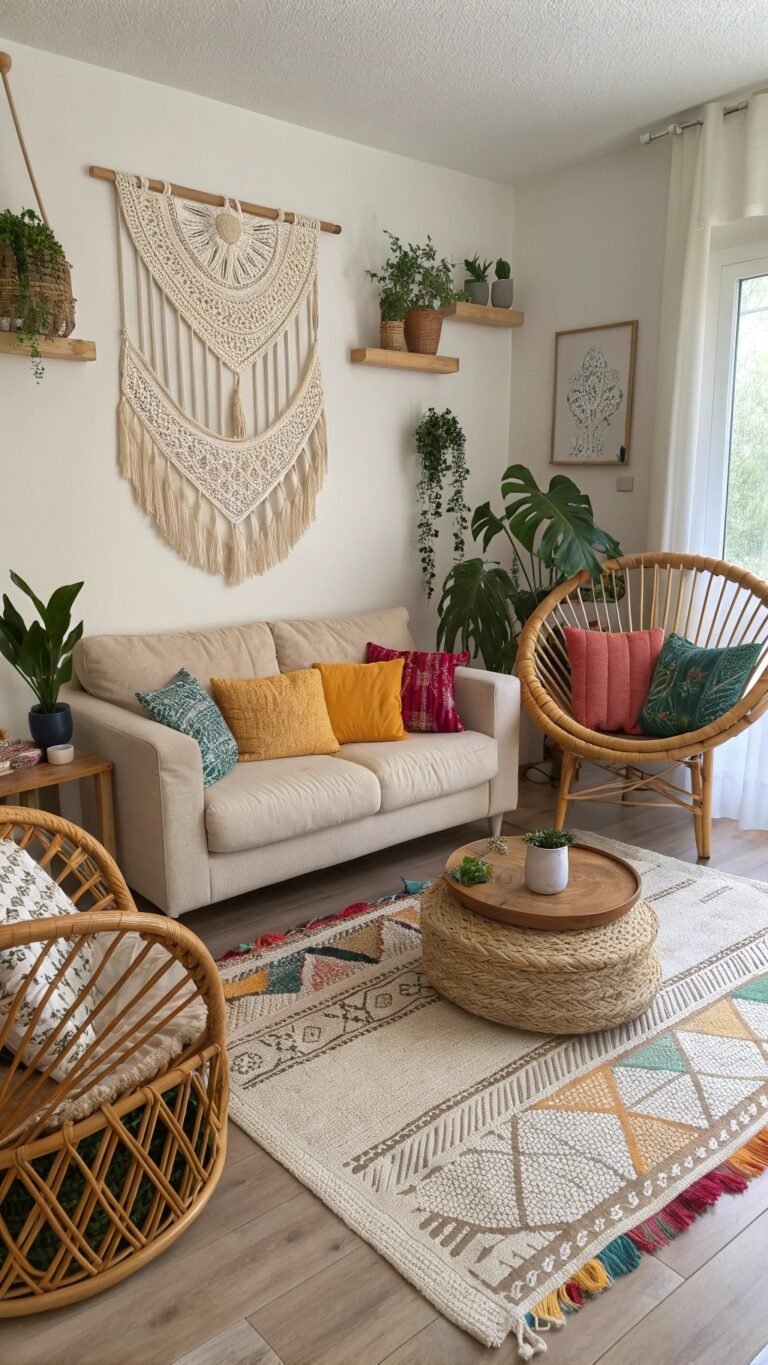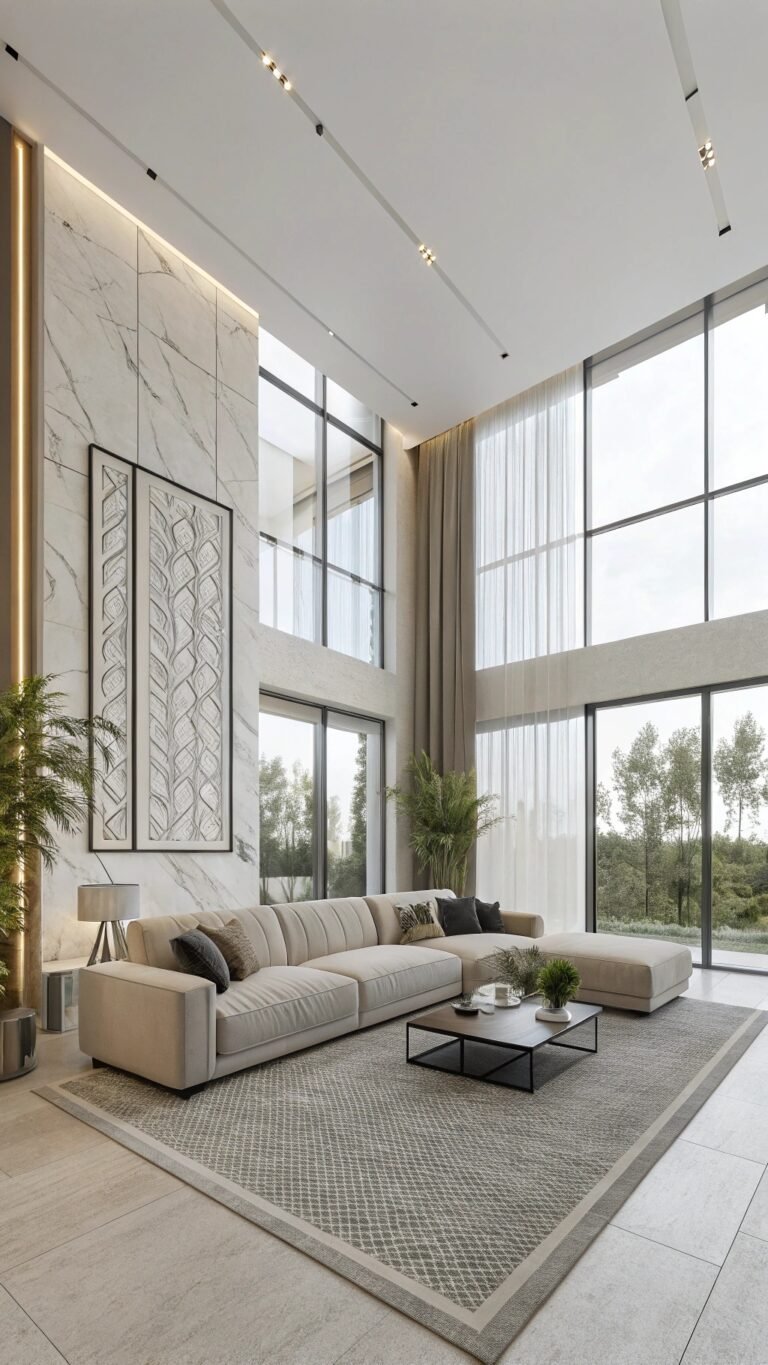Mid Century Modern Living Room: 17 Ideas That Nail Iconic Style (Without Feeling Like a Museum)
Mid century modern living room style is soaring because it blends warmth, simplicity, and timeless craftsmanship. Low-slung silhouettes, honest wood tones, and sculptural lighting feel both retro and refreshingly modern.
With a few smart swaps—sofa legs, lighting, and a hero credenza—you can channel the era’s optimism while keeping everyday comfort front and center.
1) The Iconic Low Sofa with Tapered Legs
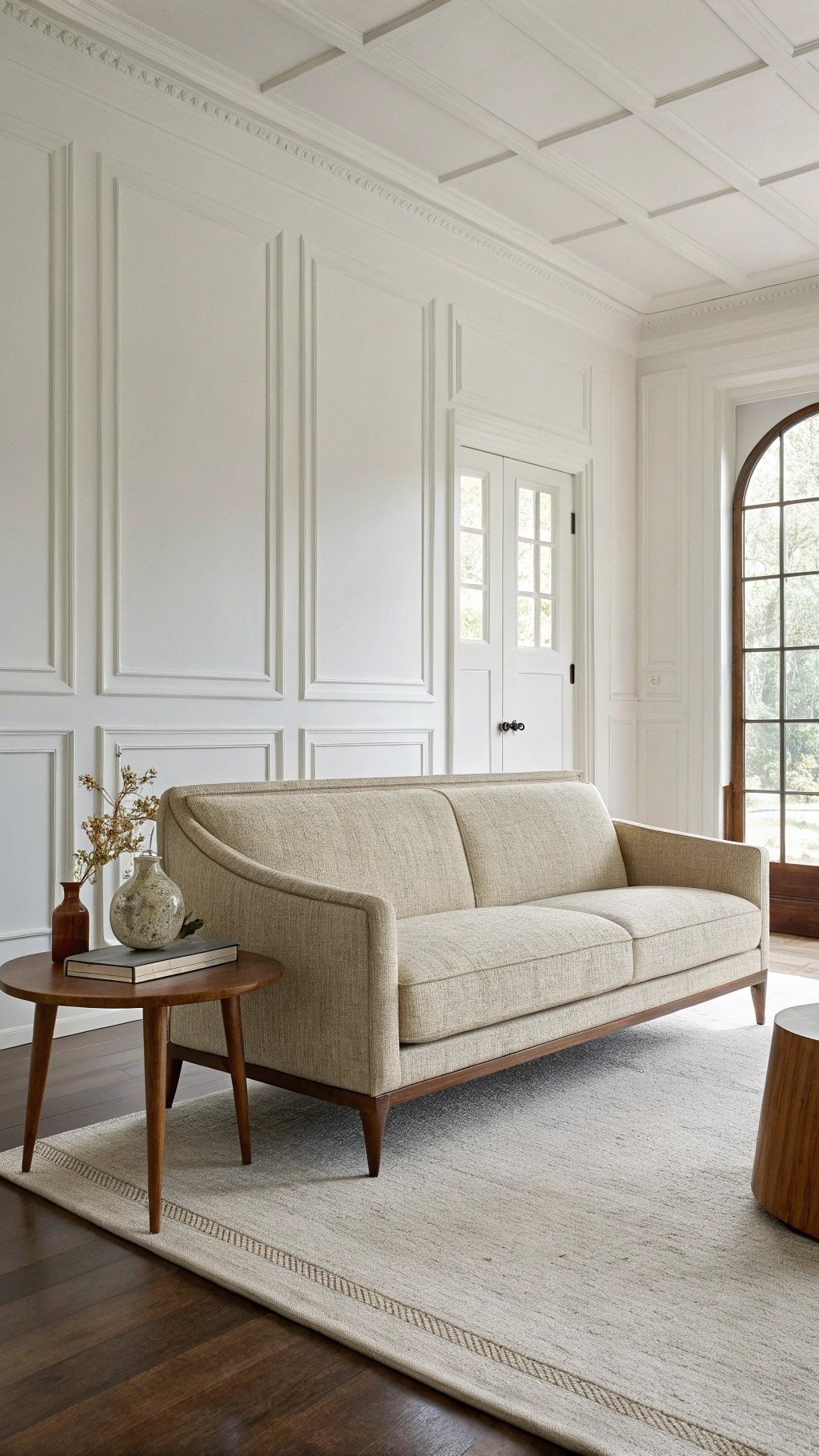
Choose a streamlined sofa with a tight back, bench seat, and visible tapered legs. Keep the arms slim to open sightlines and select a durable wool-blend or textured linen that wears well.
The low profile makes ceilings feel higher, while the lifted base shows more rug, creating airiness even in compact rooms.
What makes something unique:
Contrast upholstery with walnut or teak legs and add a single, long lumbar pillow in a geometric weave rather than a pile of cushions.
Pair the sofa with a petite drum side table to preserve negative space. This minimal mix reads authentically mid-century without sacrificing the sink-in comfort you want today.
2) Walnut & Teak Wood Story
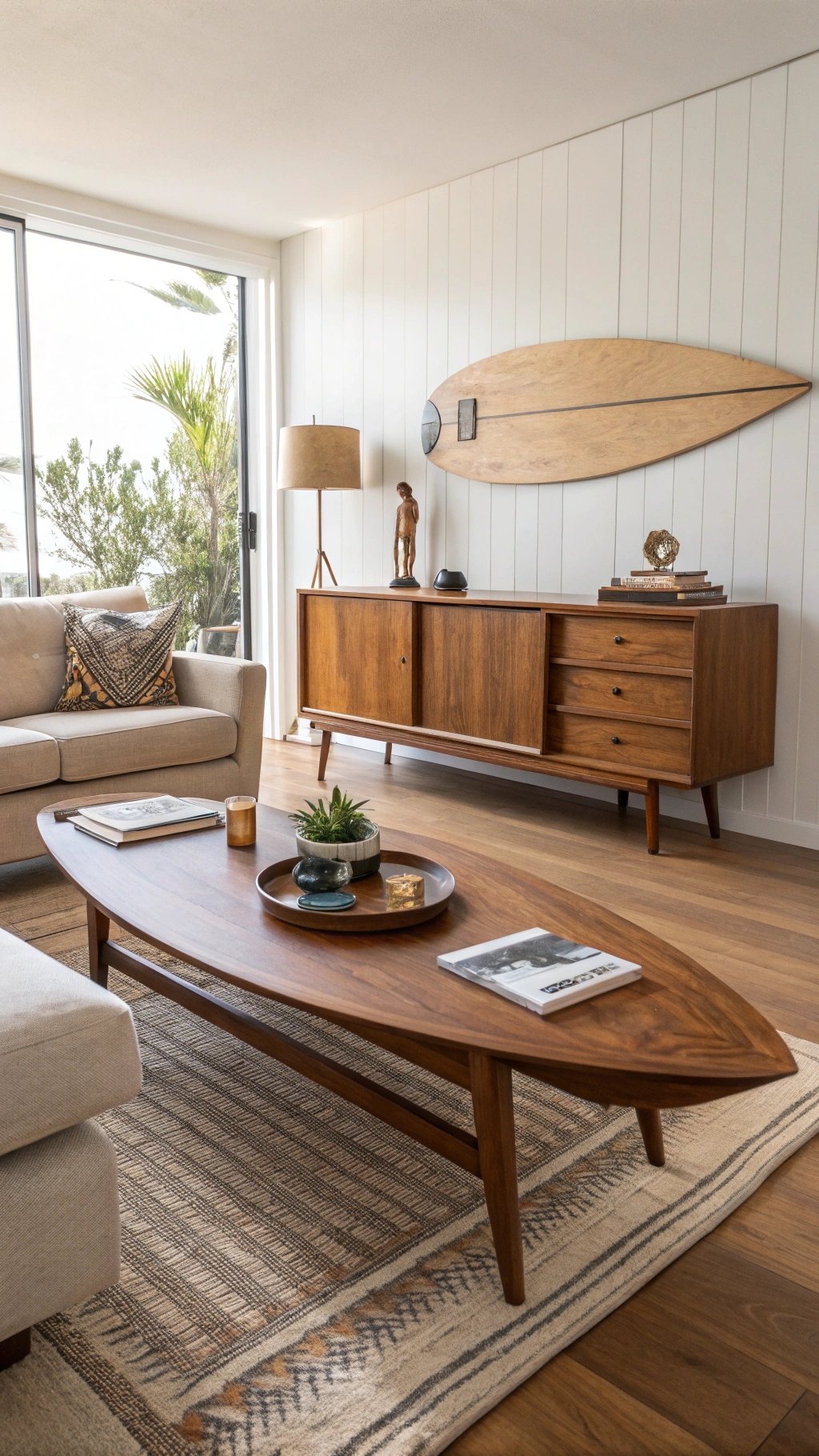
Mid-century rooms revolve around warm wood. Anchor the space with a walnut coffee table, teak credenza, or slatted paneling.
Let grain be the “pattern,” then keep textiles quieter. Oil-finished surfaces glow under warm light, and a single vintage piece instantly adds soul to new builds or rentals.
What makes something unique:
Echo the same wood tone in at least two places—coffee table and picture frames, credenza and chair arms—so the palette feels intentional.
Mix in one contrasting species (e.g., oak floors) for relief. The disciplined repetition reads curated, not matchy, and it spotlights the craftsmanship that defines the era.
3) Open, Low, and Loungey Layout
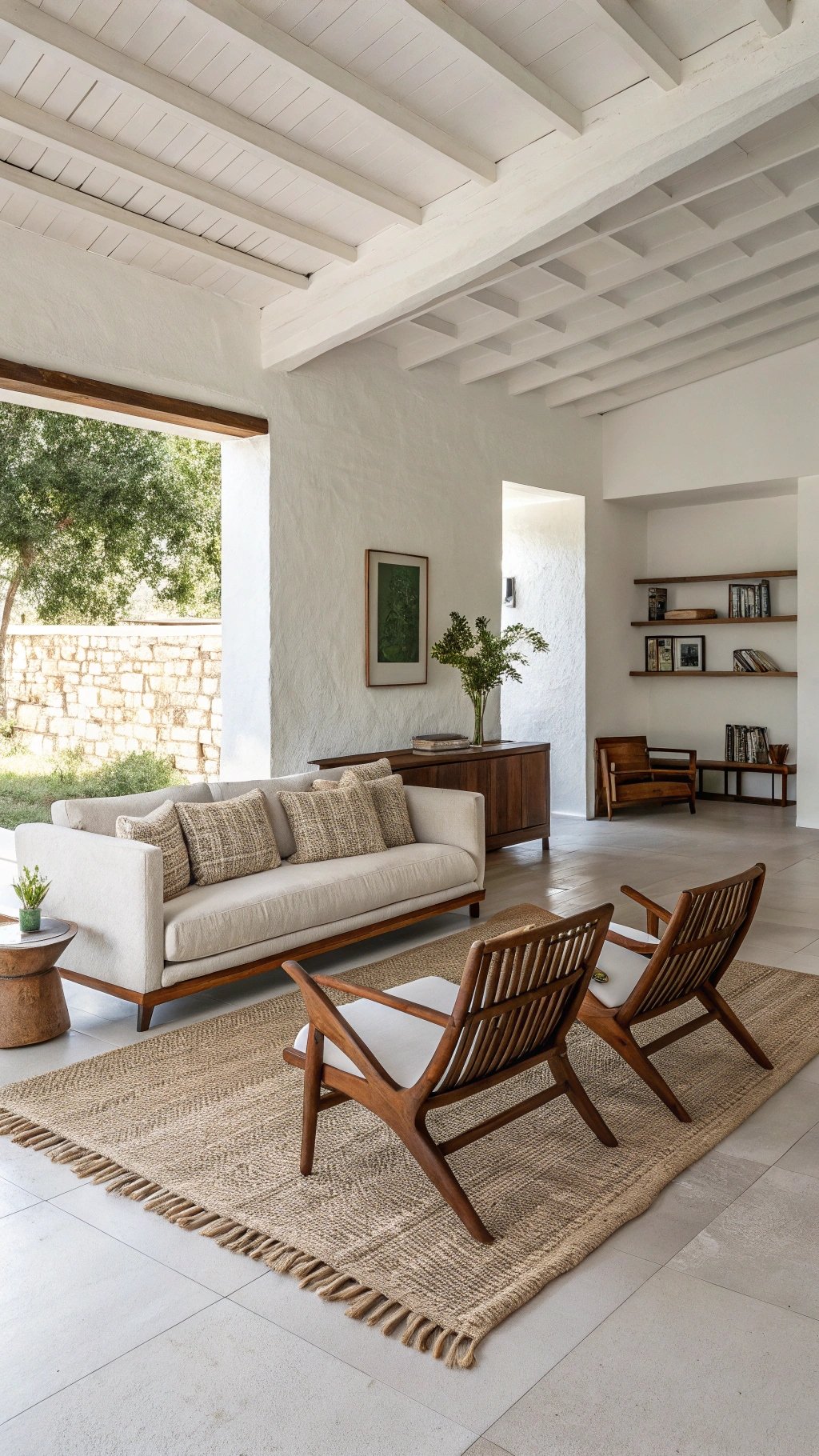
Keep furniture low and floating off the walls to mimic the easy flow of mid-century homes. Use an airy chair pair opposite the sofa and a long rug to visually stitch pieces together.
Keep pathways generous; the look should feel social, informal, and ready for long conversations.
What makes something unique:
Choose slender-legged chairs to preserve floor visibility and add a narrow bench instead of bulky ottomans for flexible seating.
A low console behind the sofa organizes clutter while maintaining the horizon line. The entire plan reads relaxed and precise—the sweet spot of mid-century living.
4) Sculptural Lighting: Saucer & Sputnik
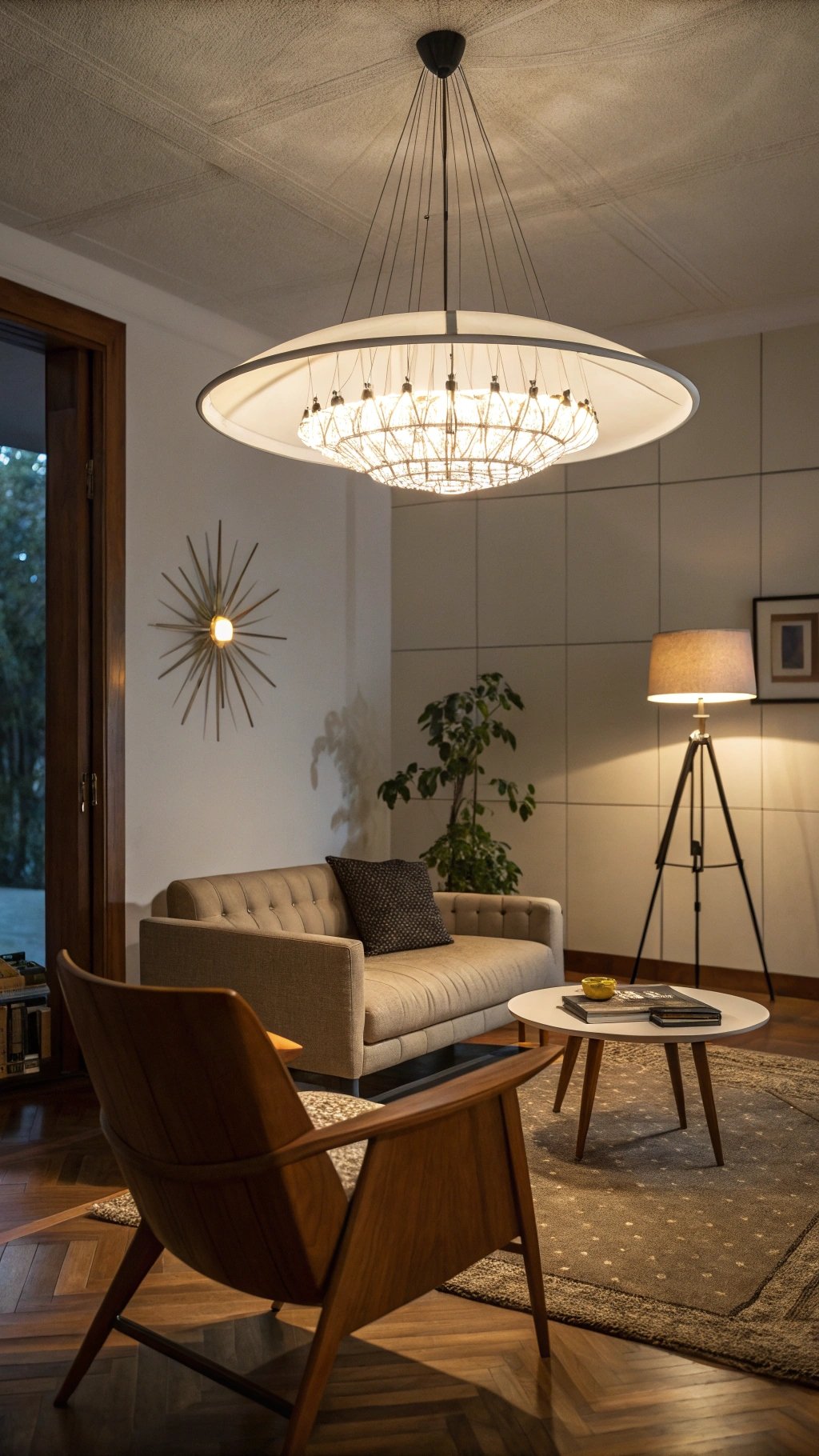
Lighting is jewelry in a mid-century room. A Saucer pendant or Sputnik chandelier instantly sets the tone, supported by a tripod floor lamp and petite table lamps.
Aim for warm 2700–3000K bulbs that flatter wood and textiles, and keep shades simple—linen, opal glass, or spun metal.
What makes something unique:
Repeat finishes thoughtfully: brushed brass on the chandelier, echoed on a picture light and small frame. Add a tiny uplight behind a plant for night drama.
The choreography of glow and shadow turns simple furniture into a cinematic scene without extra objects.
5) Graphic Rugs & Geometric Textiles
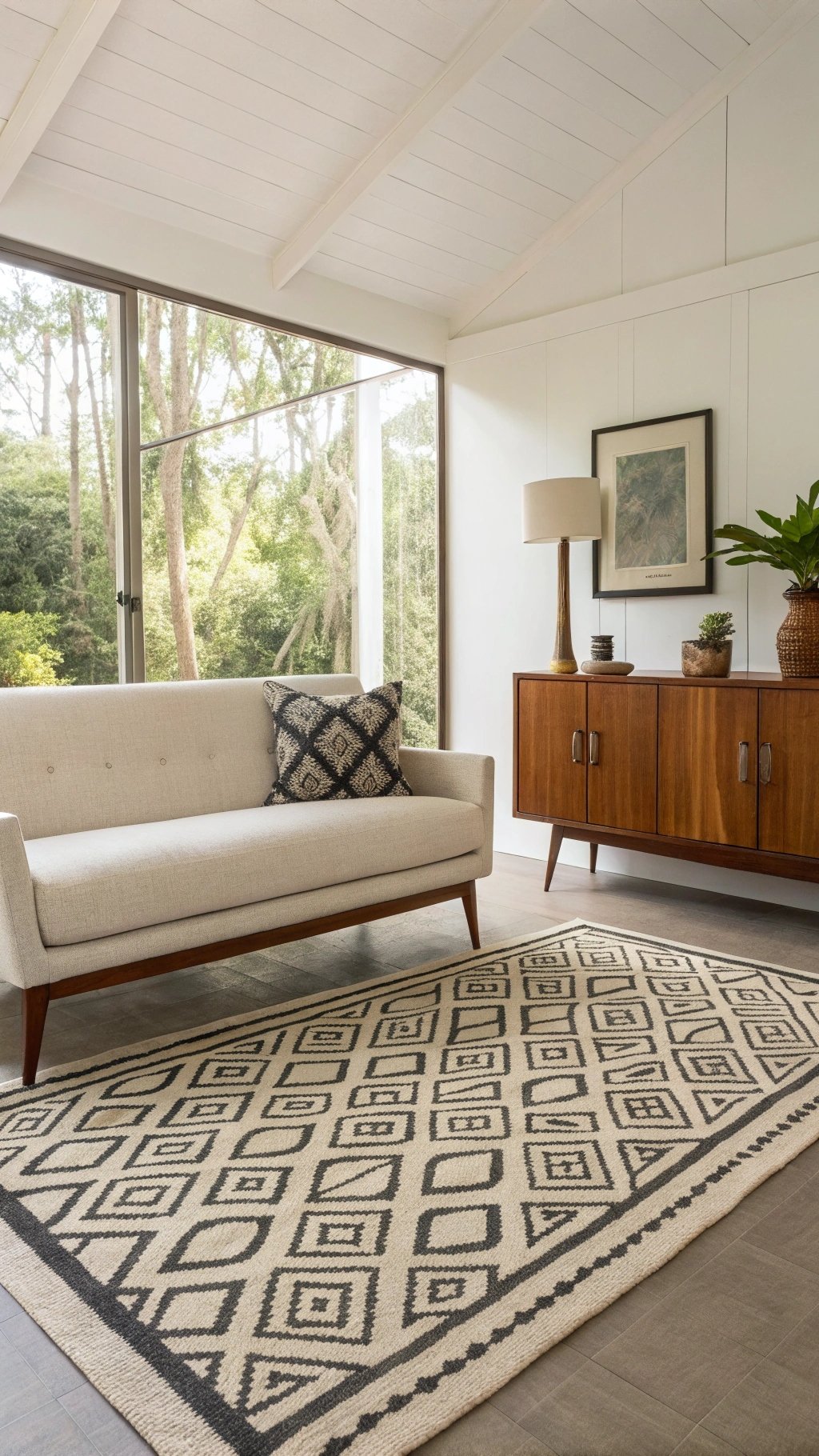
Introduce pattern through a flatweave rug or upholstery with era-true motifs—atomic dots, chevrons, or grid lines.
Keep the color story tight (two or three tones max) so shapes don’t overwhelm. Use texture elsewhere—bouclé pillow, felt throw—to ground the crisp geometry.
What makes something unique:
Place pattern at the floor and keep upper planes quieter for visual balance. Echo one motif on a single lumbar pillow or a small framed textile.
The restrained repeat reads deliberate and supports, rather than competes with, your statement lighting and wood grain.
6) Color Pops the Era Loved
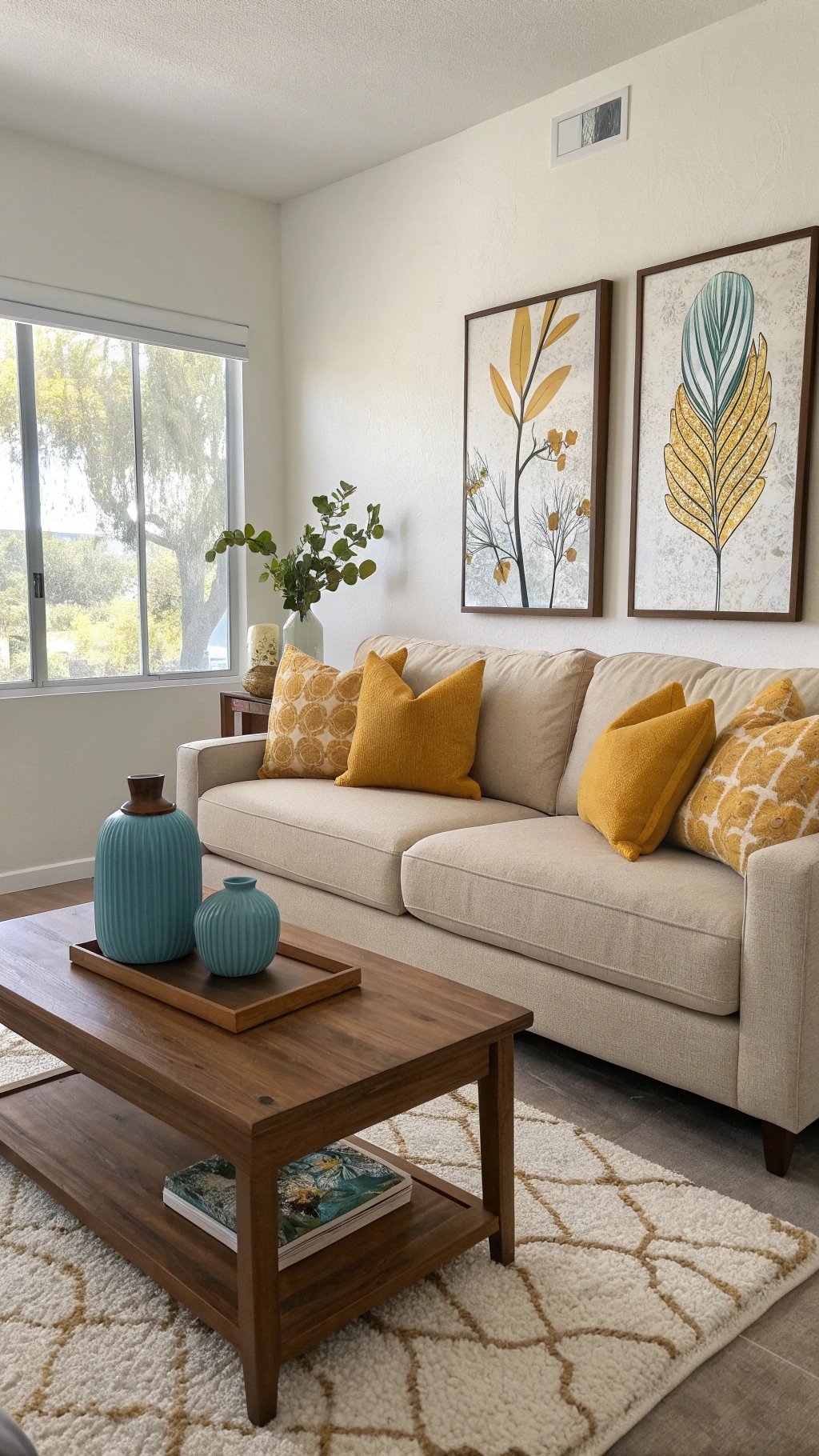
Work neutrals plus one saturated pop—mustard, teal, tomato red, or avocado. Keep the pop in movable pieces: cushions, a lacquer tray, or a ceramic lamp.
The restraint keeps things timeless, not theme-park, and makes seasonal swapping painless.
What makes something unique:
Repeat the accent color exactly three times across the room for cohesion—a pillow, art detail, and vase—then stop. Let wood and white breathe around it.
The precise count creates rhythm without clutter, giving you that magazine “edited” finish.
7) The Essential Credenza (Media-Ready)
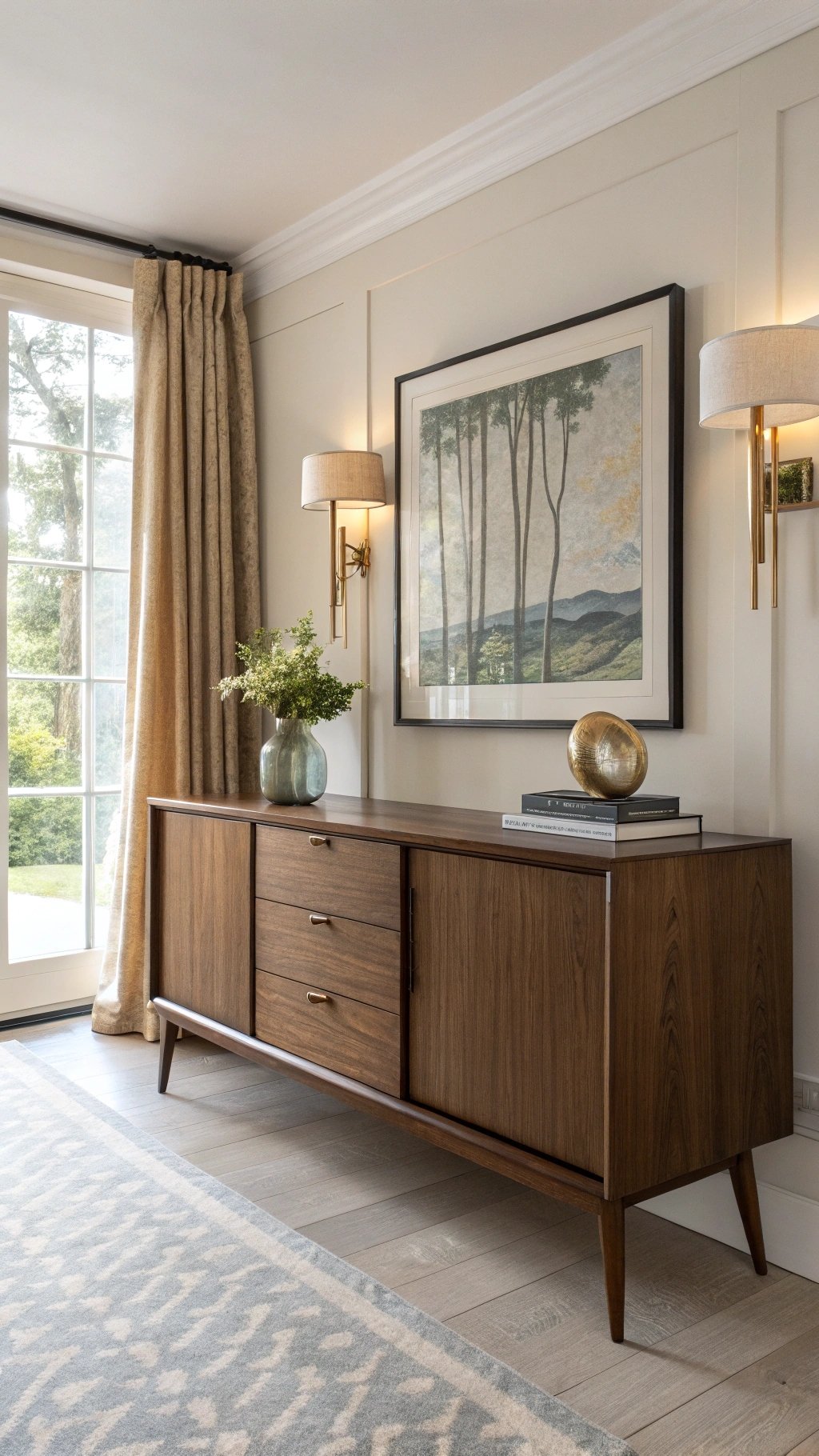
A low, long credenza organizes tech while delivering mid-century lines. Look for sliding doors, finger pulls, and interior cord management.
The top becomes a styling stage for a lamp, favorite books, and a single sculpture.
What makes something unique:
Specify a floating mount or slim pencil legs for a light footprint. Add a brass picture light above a single artwork hung low over the credenza.
The stacked horizontal forms feel intentional and keep the TV area curated rather than utilitarian.
8) Icon Chairs that Work Hard
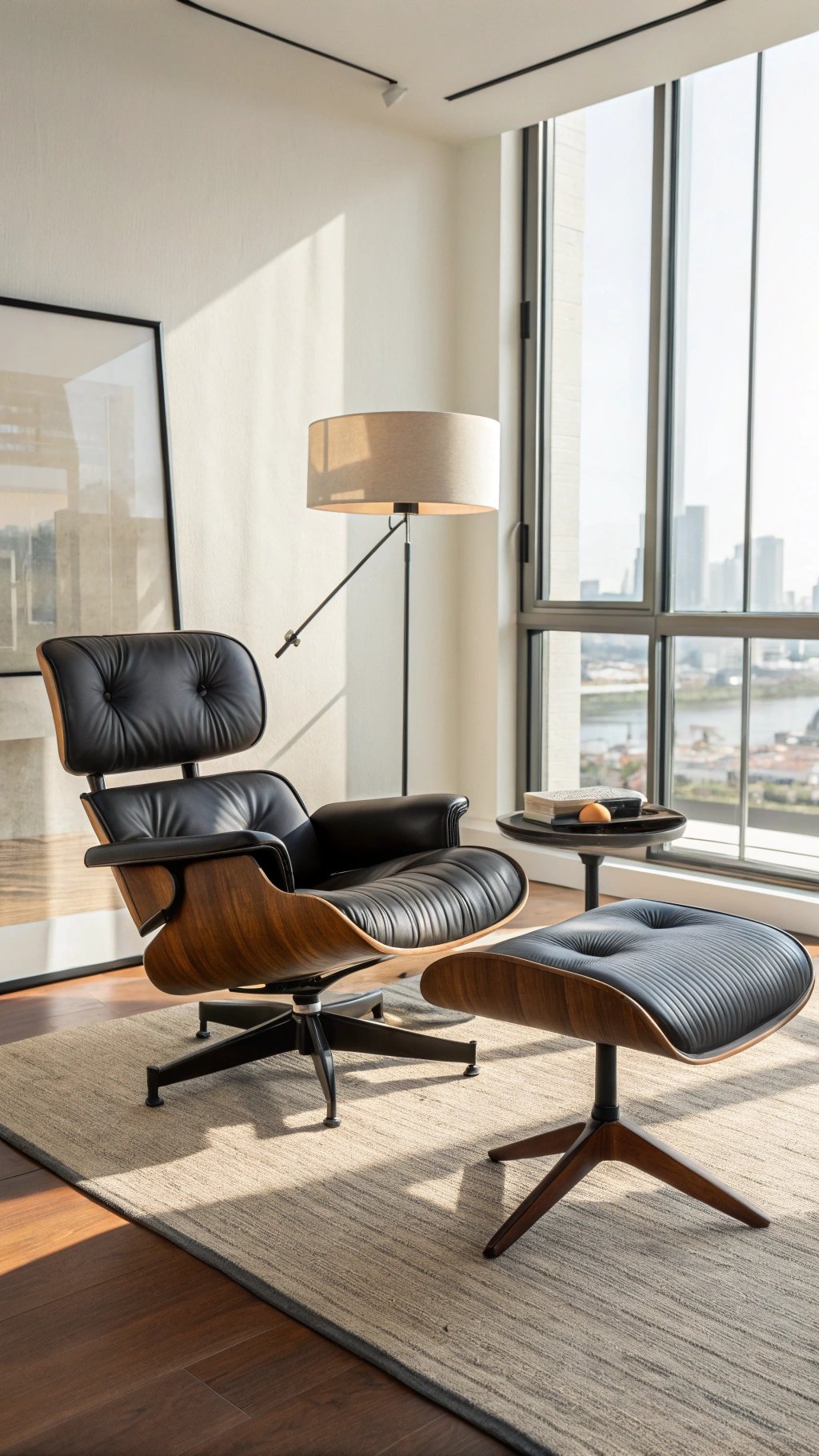
Bring in one hero lounge chair—Eames Lounge, Womb, or a walnut scoop chair. Place it where light hits naturally for reading.
Balance with a small pedestal side table so the chair has a landing zone without adding bulk.
What makes something unique:
Echo the chair’s material elsewhere: a walnut frame on art if the chair has walnut shells, or a wool throw that nods to its upholstery.
This subtle mirroring elevates the piece from “object” to anchor, unifying the composition.
9) Surfboard or Boomerang Coffee Table
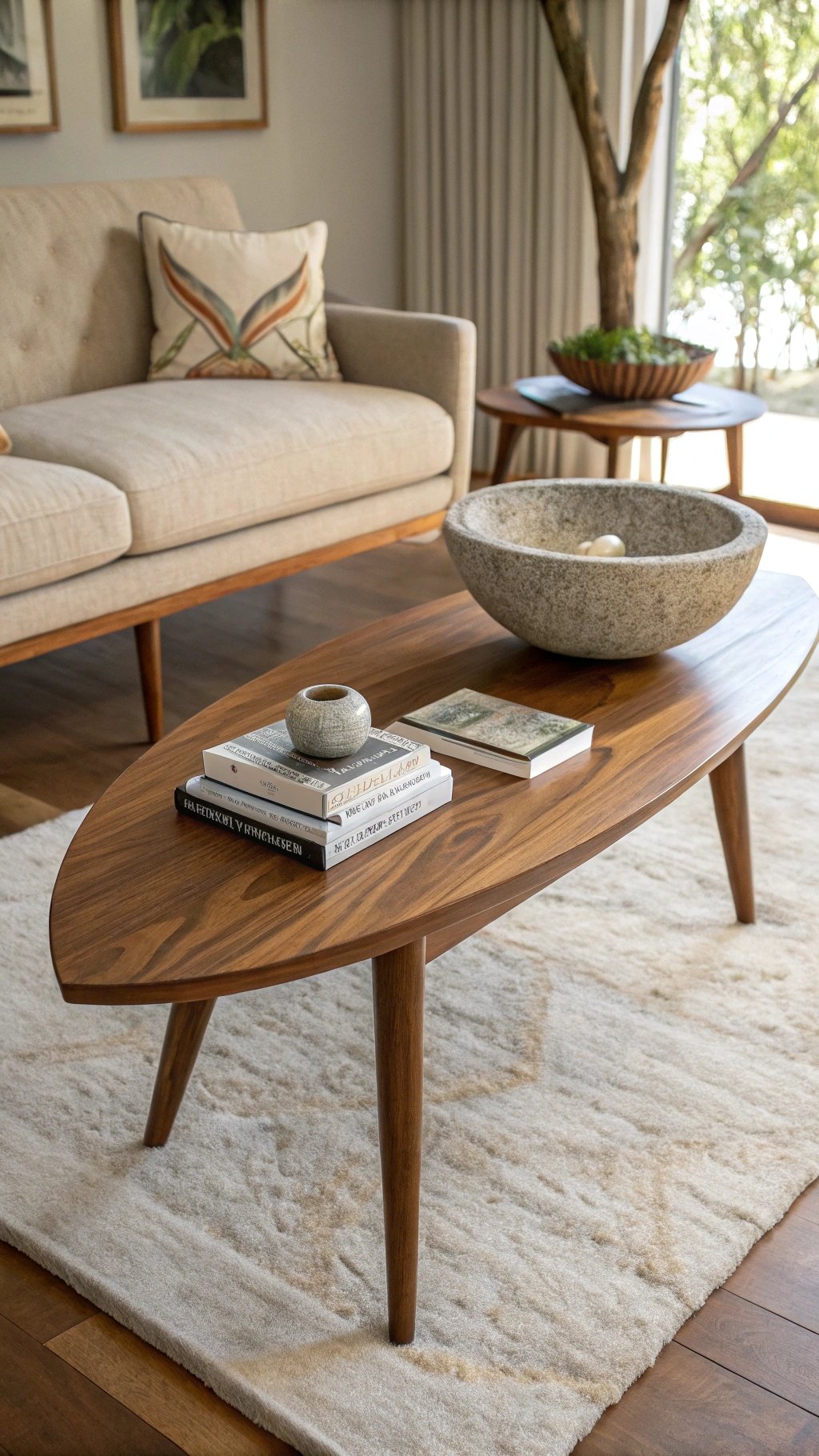
Swap heavy rectangles for a biomorphic surfboard or triangular boomerang table. These organic shapes invite flow around the seating group and feel period-correct without shouting.
What makes something unique:
Choose a table with visible edge detail and tapered legs, then keep tabletop styling low—one stone bowl and two books—to honor the silhouette. The negative space around the curved form becomes part of the room’s rhythm.
10) Brick, Breeze Block, or Stacked Stone Accent
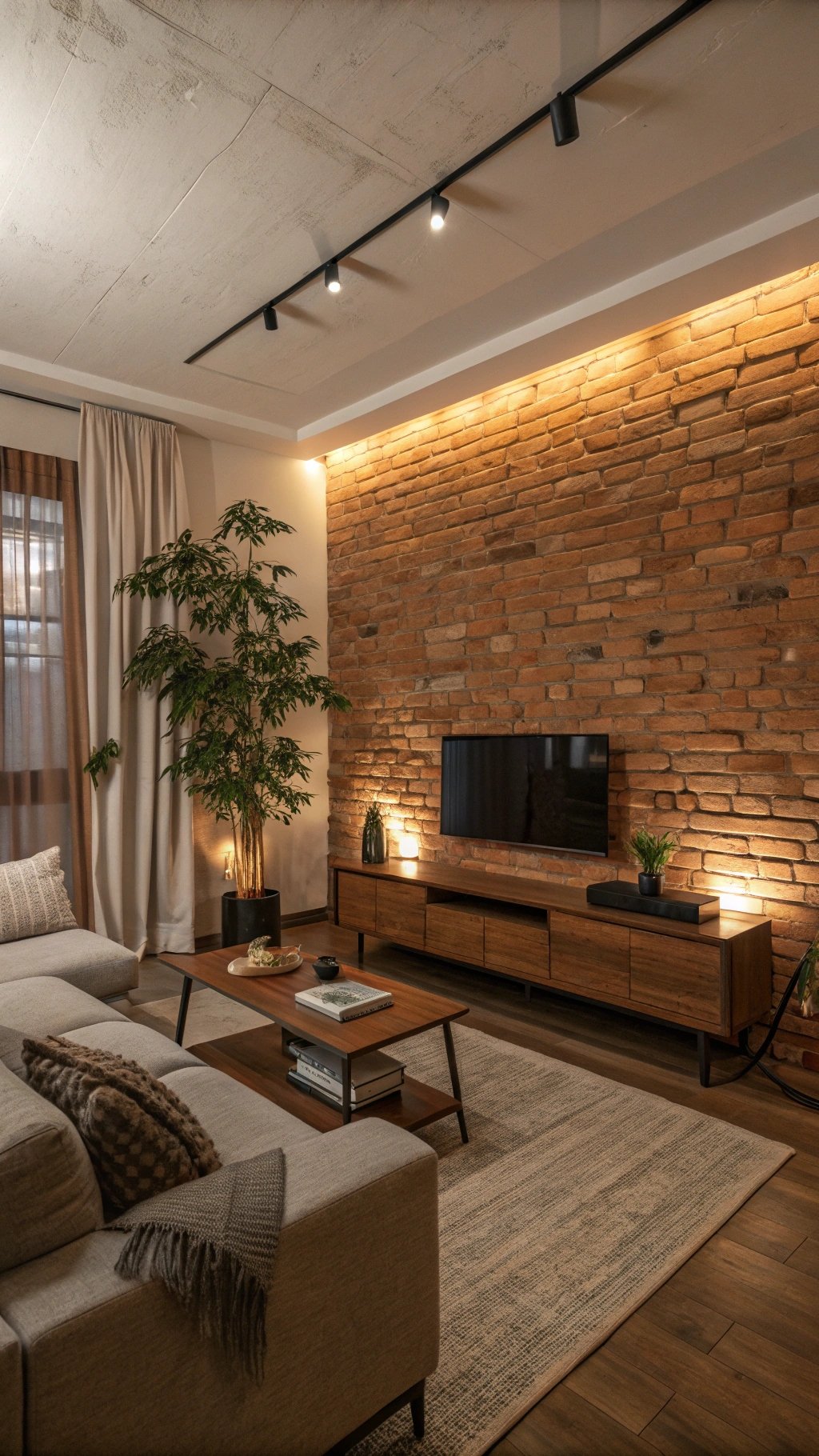
A single texture wall—exposed brick, breeze block screen, or stacked stone—grounds sleek furniture. Keep the rest of the envelope pared back so the material can breathe.
What makes something unique:
Graze the texture with a wall washer or picture lights to deepen shadows. Add one plant nearby to soften edges. The rough-meets-polished contrast is classic mid-century and photographs beautifully day and night.
11) Slim Drapery & Clerestory Vibes
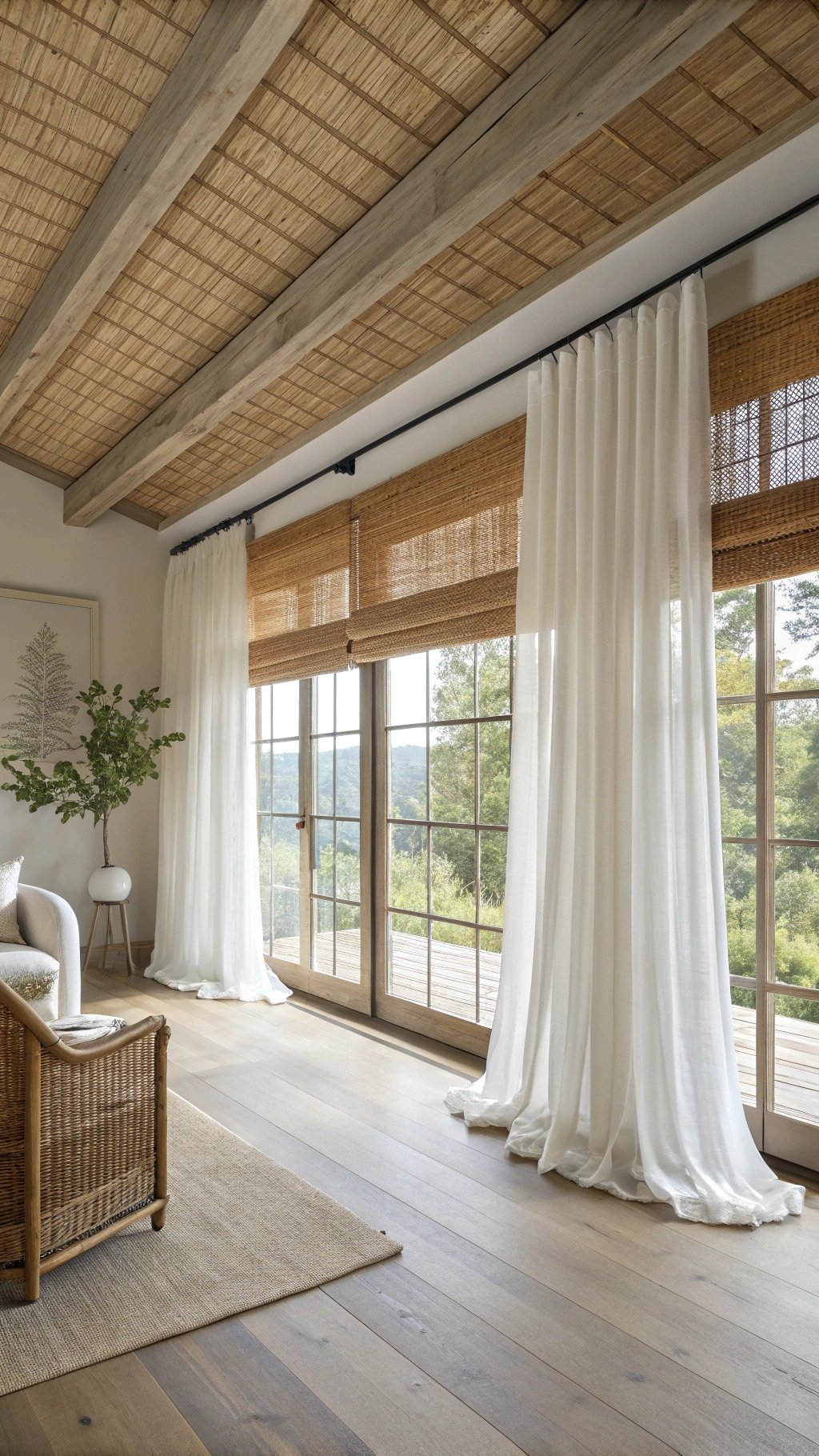
Mid-century homes embraced daylight. Use ceiling-mounted linen sheers that kiss the floor to elongate walls and preserve window geometry. If privacy allows, keep windows minimally dressed to celebrate mullions and views.
What makes something unique:
Match drapery tone to wall color for a seamless vertical plane, then add a darker woven shade inside the frame for contrast. Layers control glare while honoring the architecture—true to the era’s indoor-outdoor mindset.
12) Art That Echoes the Era
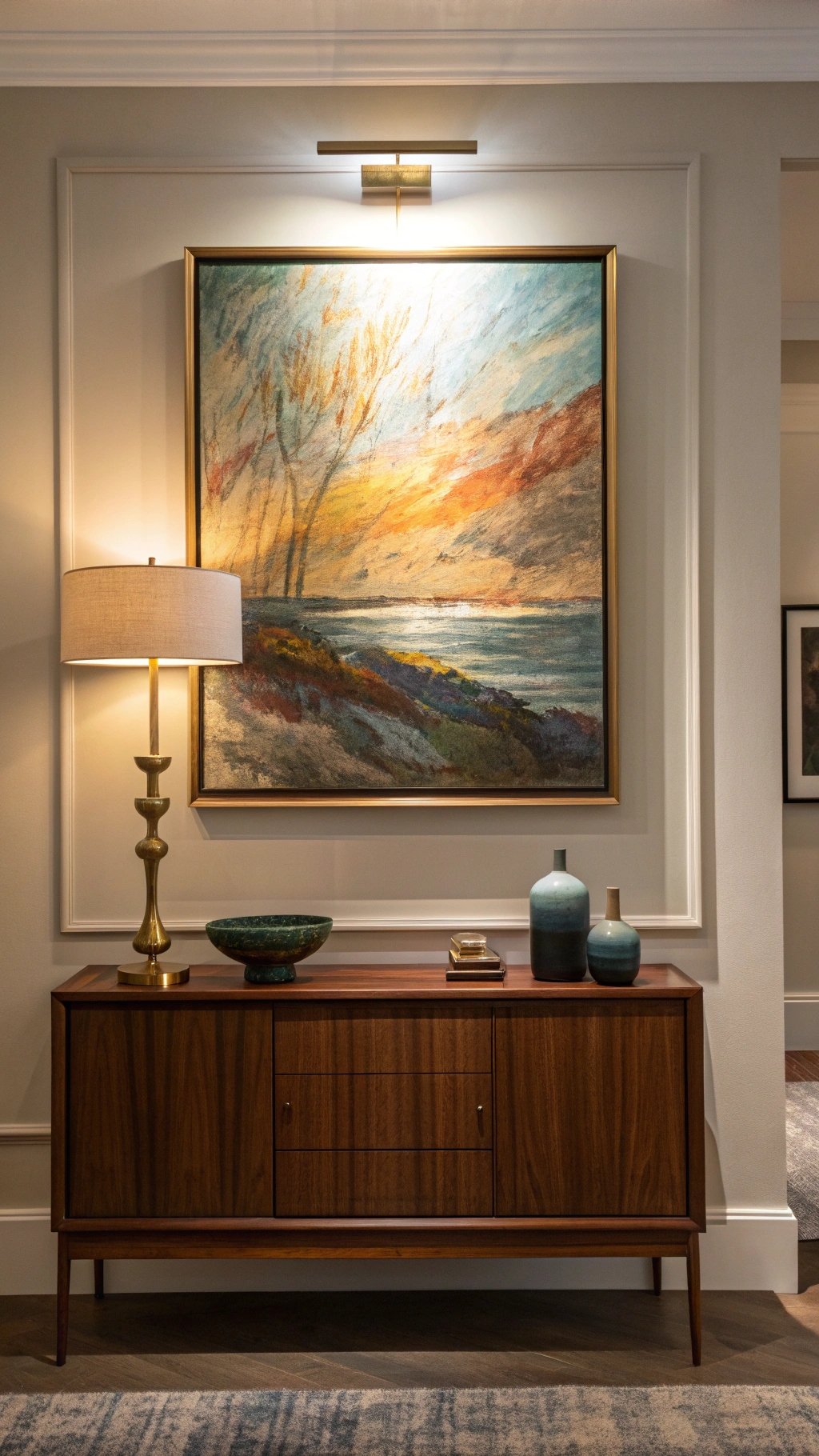
Abstracts, hard-edge graphics, and line drawings resonate with mid-century forms. Favor micro-bezel frames or thin walnut profiles.
Hang art lower than you think—aligned with the furniture horizon—to keep the room cozy and conversational.
What makes something unique:
Color-pick a tiny hue from the art and repeat it once in a vessel or pillow piping. Add a brass picture light for evening glow. The intentional echo creates a gallery feel that’s warm, not precious.
13) Plants with Architecture
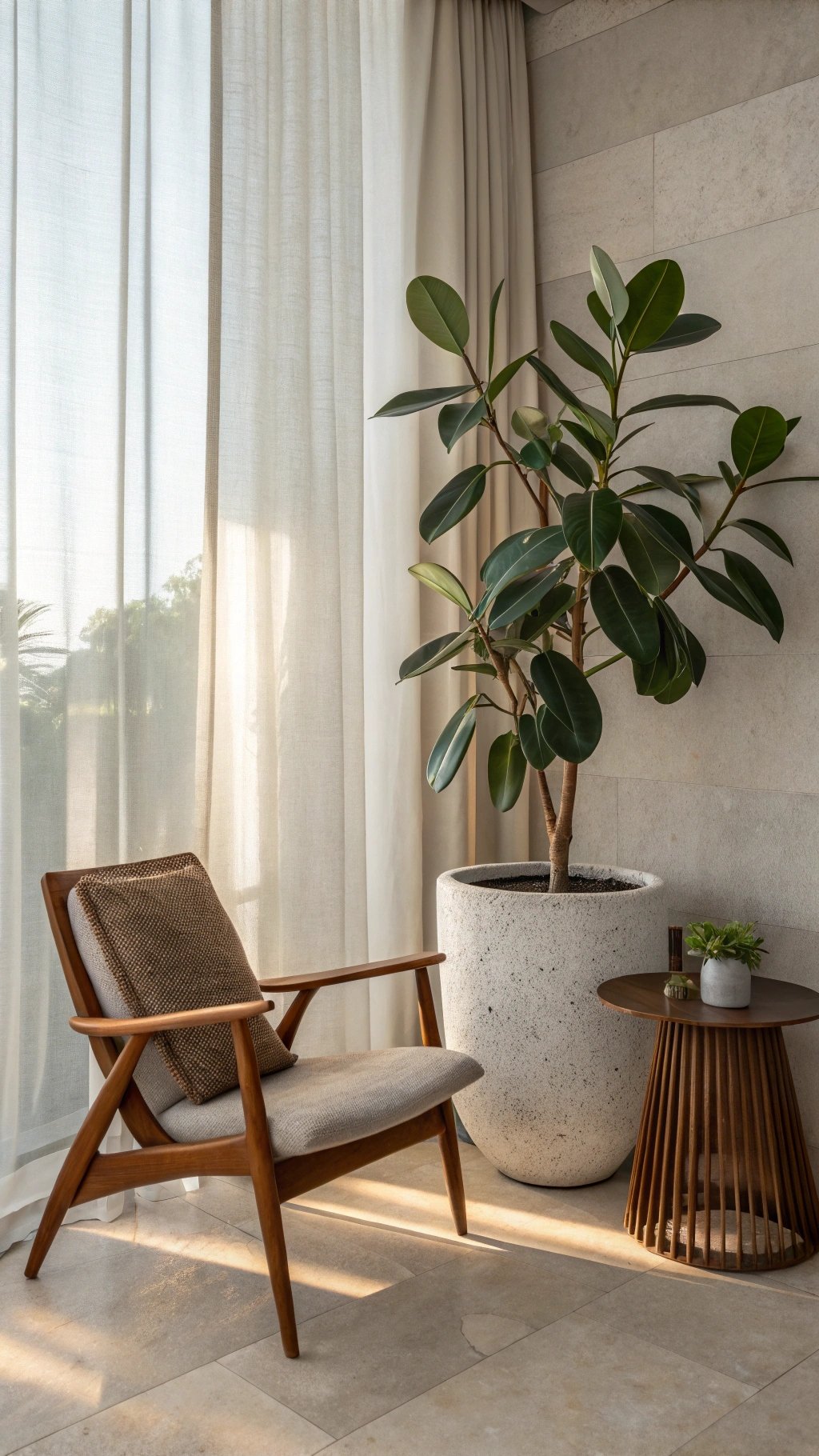
Choose structured foliage—rubber plant, fiddle-leaf fig, or olive tree—in a matte ceramic or fiberstone planter. One or two large plants beat many small pots, keeping sightlines calm and shapes sculptural.
What makes something unique:
Repeat the planter finish in a smaller tray or lamp base for cohesion. Add a tiny uplight at night to cast elegant shadows on walls. Nature becomes a living sculpture that refreshes the palette without adding visual clutter.
14) Pattern with Discipline
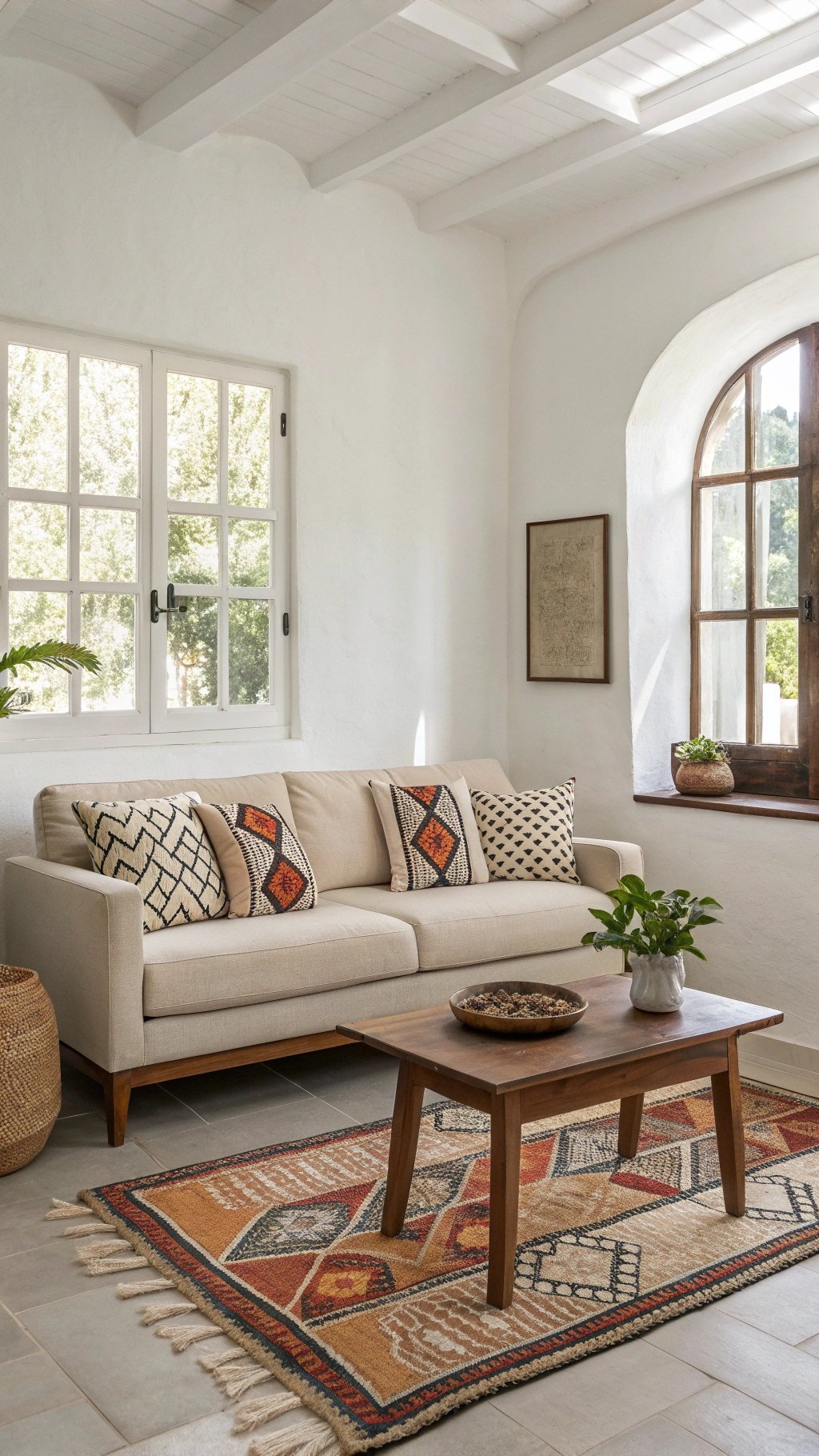
If you crave prints, limit them. One bold curtain, a pair of patterned cushions, or a small kilim is enough. The goal is rhythm, not noise, letting wood grain and silhouettes stay hero.
What makes something unique:
Anchor patterns with a solid color block—mustard cushion or teal throw—repeated sparingly. The controlled mix reads curated and preserves the restful, architectural feel that makes mid-century so livable.
15) Small Living Room, Big Mid-Century Energy
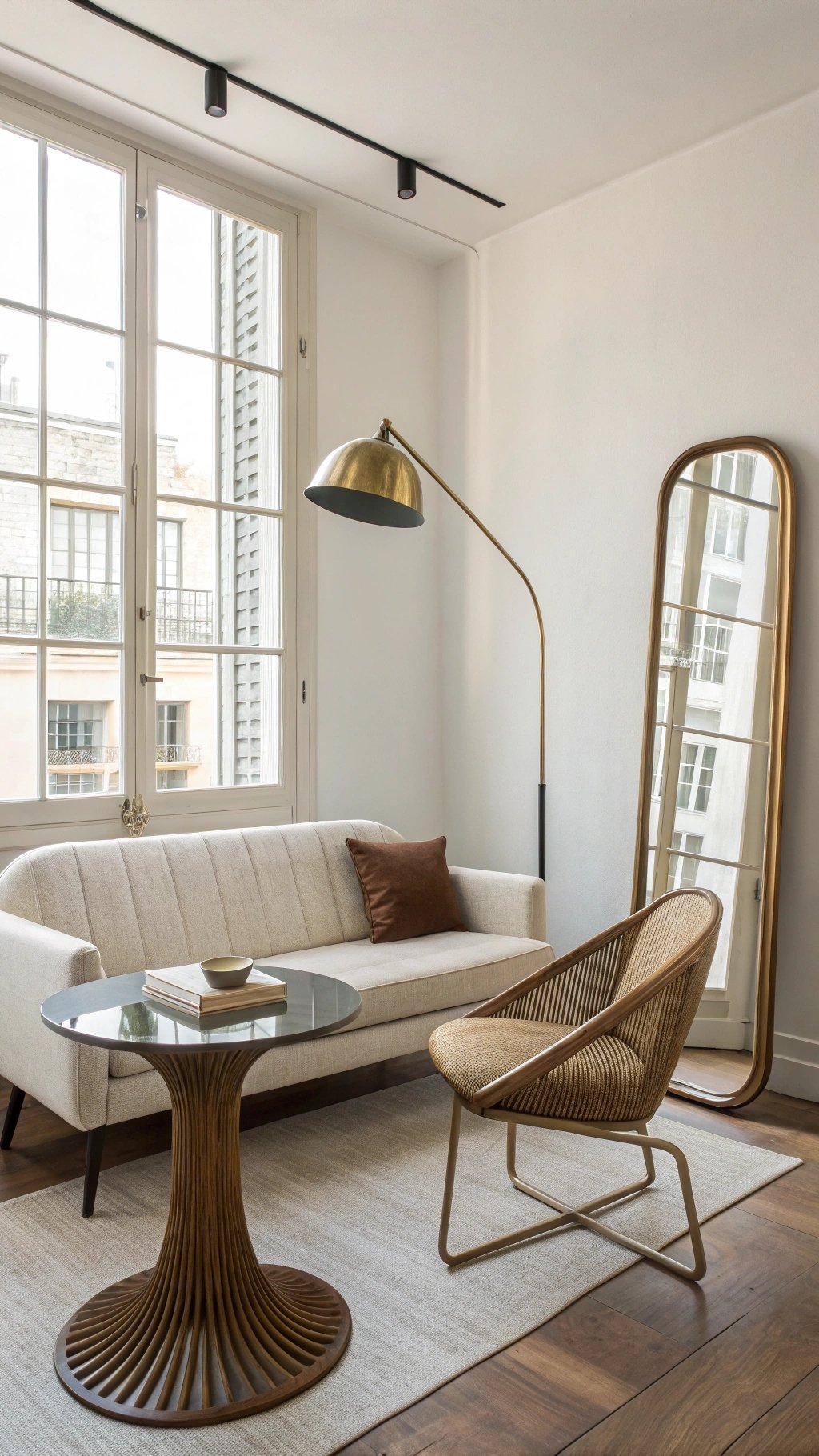
Scale down without losing character: a 72–78″ sofa, petite boomerang table, and armless slipper chair keep circulation open. Mirrors opposite windows widen the view; a single oversized artwork keeps focus tight.
What makes something unique:
Wall-mount a swing-arm lamp to free tabletops and use a narrow console with stools tucked beneath for extra seating. The layout feels flexible and social—mid-century values in a city footprint.
16) Mixed Materials, One Palette
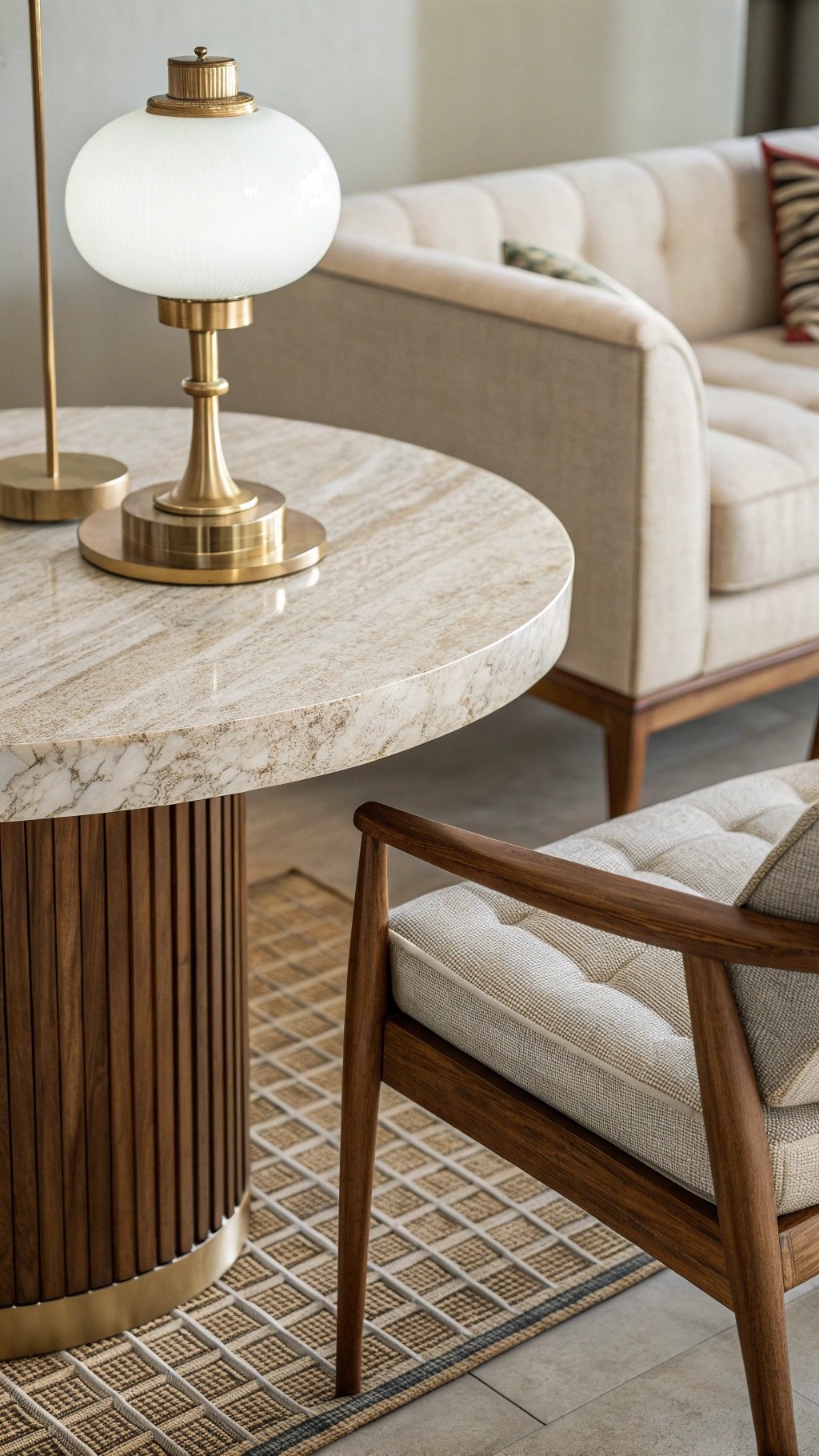
Blend walnut, travertine, opal glass, and brushed brass within a restrained color story—bone, camel, charcoal. Let materials deliver interest instead of busy patterns. Low sheen finishes read richer and photograph better.
What makes something unique:
Echo each material twice—stone coffee table and stone bowl, brass lamp and brass picture light, walnut chair and walnut frames—so the room feels intentionally layered. It’s a grown-up way to honor mid-century’s material honesty.
17) Vintage + Sustainable Sourcing
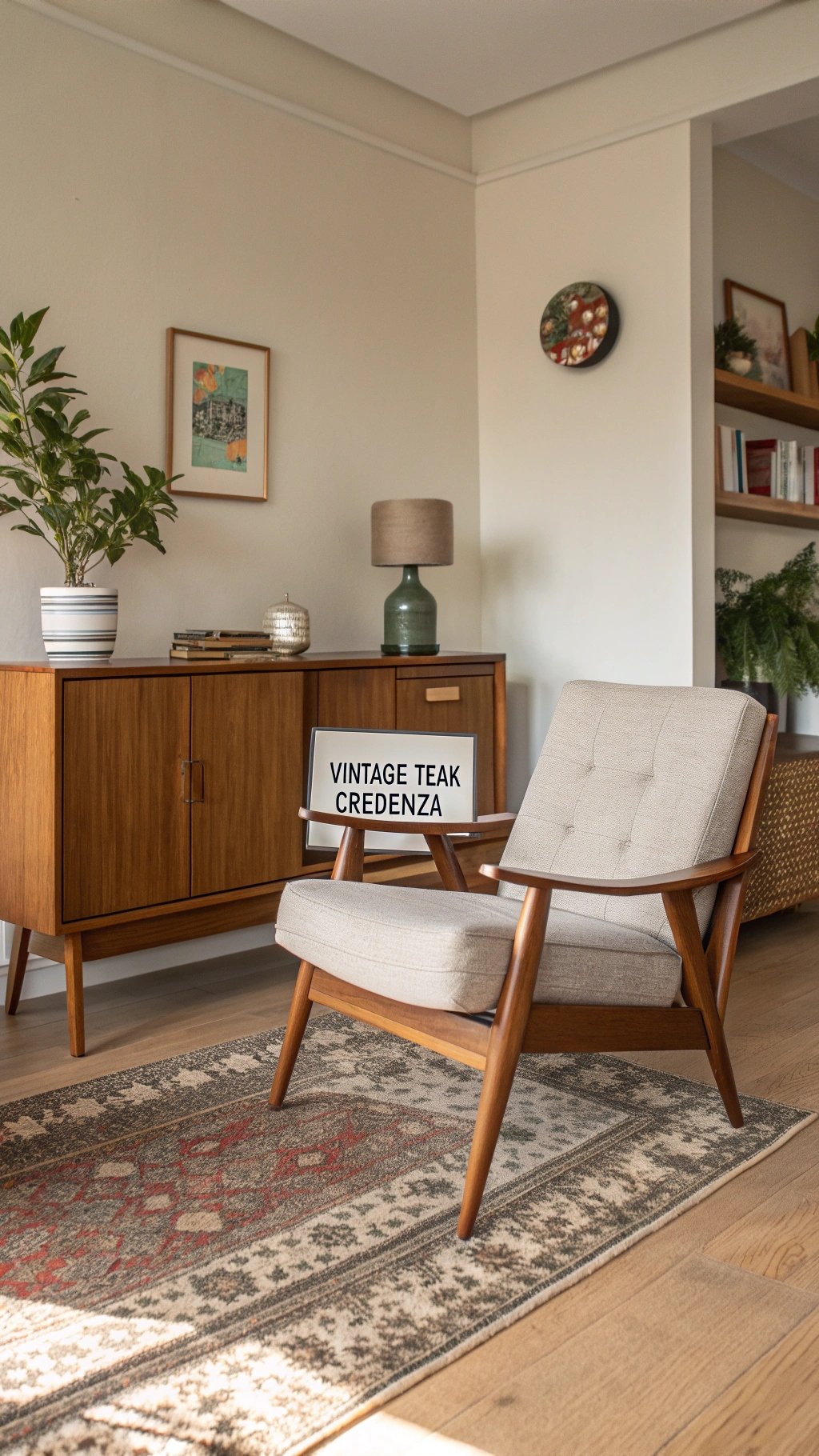
Hunt secondhand for credenzas, chairs, and lighting. Vintage pieces cut waste and bring real patina. Reupholster with durable, natural fabrics and refresh wood with gentle oil rather than heavy varnish to preserve character.
What makes something unique:
Tell the story in your styling: a small card under a lamp noting designer and year, a book open to the piece’s original ad. The context elevates the room from “styled” to “collected,” turning sustainability into part of the charm.
Quick Tips to Nail a Mid Century Modern Living Room
Keep profiles low, legs visible, and pathways open.
Repeat wood tones and metals deliberately for cohesion.
Let one showpiece (light, credenza, or chair) lead—support it with calm textiles and a disciplined color pop.

